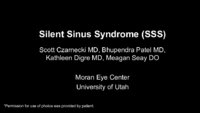John A. Moran Eye Center Neuro-Ophthalmology Collection: A variety of lectures, videos and images relating to topics in Neuro-Ophthalmology created by faculty at the Moran Eye Center, University of Utah, in Salt Lake City.
NOVEL: https://novel.utah.edu/
TO
| Identifier | Title | Description | Subject | ||
|---|---|---|---|---|---|
| 26 |
 |
Retinitis pigmentosa disease of rods.pdf | Retinitis Pigmentosa Disease of Rods | Discussion of retinitis pigmentosa which is a retinal/choroidal degeneration caused by various genetic defects. | Retinitis Pigmentosa; Rods |
| 27 |
 |
Retino-choroidal Vessels or Optociliary veins or ciliary shunt.pdf | Retino-choroidal Vessels or Optociliary Veins or Ciliary Shunt | Overview of retino-choroidal collaterals, which are potential telangiectatic connections between the retina and choroidal circulation. Although sometimes called "shunts", these collaterals are between the retinal venous circulation and the choroidal venous circulation. | Retino-choroidal Vessels; Optociliary Veins ; Ciliary Shunt |
| 28 |
 |
Shaken Baby Syndrome | Shaken Baby Syndrome | Ocular Manifestations of Child Abuse | |
| 29 |
 |
SEAY_Silent_Sinus_Syndrome | Silent Sinus Syndrome | Silent sinus syndrome (SSS) is characterized by spontaneous and progressive unilateral enophthalmos. | Silent Sinus Syndrome (SSS) |
| 30 |
 |
Spiral_and_Stellate_Visual_Fields_Non-physiologic_Variants | Spiral and Stellate Visual Fields Non-physiologic Variants | Description of testing the spiral and stellate visual fields. | Spiral; Stellate; Visual Fields |
| 31 |
 |
Stages of Papilledema | Stages of Papilledema | Papilledema Stages; Raised Intracranial Pressure | |
| 32 |
 |
Stargardt's Disease.pdf | Stargardt's Disease | Discussion of Stargardt's disease, an inherited maculopathy which frequently presents with a loss of central vision. | Stargardt's Disease; Maculopathy |
| 33 |
 |
Tangent_screen_recording_chart | Tangent Screen Recording Chart | The tangent screen recording chart. | Tangent Screen |
| 34 |
 |
Tangent_Screen_Testing_Visual_Field | Tangent Screen Testing Visual Field | Description of tangent screen testing. | Tangent Screen; Visual Fields |
| 35 |
 |
The_3_Step_Test_Digre.pdf | The 3 Step Test: Looking for a 4th Nerve Palsy | Description of the three step test (3 step test) used when looking for a 4th nerve palsy. | 3 Step Test |
| 36 |
 |
Webvision-EOG-Creel | The Electro-oculogram: Clinical Applications | The electrooculogram measures the potential that exists between the cornea and Bruch's membrane at the back of the eye. The potential produces a dipole field with the cornea approximately 5 millivolts positive compared to the back of the eye, in a normally illuminated room. Although the origin of th... | Electro-oculogram |
| 37 |
 |
Webvision-ERG-Creel | The Electroretinogram and Electro-oculogram: Clinical Applications | The global or full-field electroretinogram (ERG) is a mass electrical response of the retina to photic stimulation. The ERG is a test used worldwide to assess the status of the retina in eye diseases in human patients and in laboratory animals used as models of retinal disease. | Electroretinogram; Electro-oculogram |
| 38 |
 |
Webvision-mfERG-Creel | The Multifocal Electroretinogram: Clinical Applications | The most important development in ERGs is the multifocal ERG (mfERG). Erich Sutter adapted the mathematical sequences called binary m-sequences creating a program that can extract hundreds of focal ERGs from a single electrical signal. This system allows assessment of ERG activity in small areas of ... | Multifocal Electroretinogram |
| 39 |
 |
walsh_2000_c30 | The Wall-Eyed Potato Farmer | Young man presenting with apparent episodic neurologic evants that initially was thought to be multiple sclerosis, but as time went on, he had progressive changes in his neurologic exam and in his imaging findings. Brain biopsy revealed Gliomatosis cerebri. Anatomy: Brain Stem; Pons; Midbrain. Patho... | Gliomatosis Cerebri; Intracranial Tumors; Bilateral Internuclear Ophthalmoplegia |
| 40 |
 |
Tilted_Discs_KBD.pdf | Tilted Discs | Short PowerPoint discussion of tilted discs with illustrations and images. | Tilted Disc |
| 41 |
 |
Tunnel_Vision_on_Tangent_Screen_Testing | Tunnel Vision on Tangent Screen Testing | Description of tunnel vision and tangent screen testing. | Tunnel Vision; Tangent Screen |
| 42 |
 |
Webvision-VEP-Creel.pdf | Visually Evoked Potentials | Detailed explanation of visually evoked potentials. The terms visually evoked potential (VEP), visually evoked response (VER) and visually evoked cortical potential (VECP) are equivalent. They refer to electrical potentials, initiated by brief visual stimuli, which are recorded from the scalp overl... | Visually Evoked Potentials |
| 43 |
 |
Bell_J_Neuro_GR_Duanes_PPT | Why Don't You See Double? | This presentation was given at the Neurology Grand Rounds in Fall 2011 at the University of Utah. A number of Duane Syndrome cases are covered. Related video can be found in this collection at: Duane's Syndrome Type I: http://content.lib.utah.edu/u?/EHSL-Moran-Neuro-opth,130 Duane's Syndrome Type I... | Duane's Syndrome; Duane's Type I; Duane's Type III |
